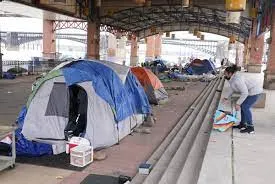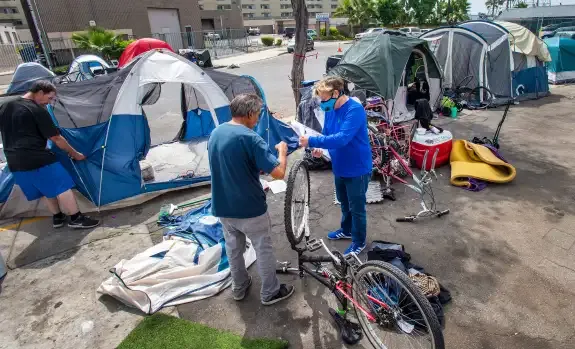
Introduction
There is an increasing number of people who are homeless is a critical issue affecting communities across the United States. A recent study conducted in California sheds light on the severity of the problem in the state.
According to the California Statewide Study of People Experiencing Homelessness, nearly one-third of the nation’s homeless population resides in California.
The study also highlights the high percentage of unsheltered individuals in the state, with almost 50% of all unsheltered people living in California.
These findings underscore the urgent need to address the housing crisis and provide support for those experiencing Homeless Population.
In this article, we will delve into the key insights from the study and explore the underlying factors contributing to the homelessness crisis in California.
1. The Study’s Findings
1.1 High Percentage of Unaffordable Housing
One of the key findings of the California Statewide Study of People Experiencing Homelessness is the high cost of housing in the state. Nearly 90% of the respondents reported that the cost of housing was the primary reason for their homelessness.
This indicates a severe shortage of affordable housing options in California. The state is known for having some of the most unaffordable places to live in the country, exacerbating the homelessness crisis.
1.2 Growing Aging Homeless Population
The study reveals that there is an increasing number of people who are homeless in California are aging. The median age of participants was found to be 47 years old, with almost half of the homeless population being 50 years old or older.
This demographic trend raises concerns about the well-being and healthcare needs of older individuals experiencing homelessness.
1.3 Ethnic Representation among the Homeless
The study also highlights the ethnic representation within the homeless population. Among those surveyed, 35% identified as Latino, 26% as Black, and 12% as Native American. These statistics draw attention to the disproportionate impact of homelessness on minority communities.
2. Implications and Challenges
2.1 Barriers to Affordable Housing
The California Statewide Study found that many individuals face significant barriers when trying to rent or buy a home. Factors such as poor credit history, discrimination, health challenges, and prior evictions make it difficult for people to secure affordable housing. These barriers contribute to the housing shortage crisis in California.
2.2 Mental Health and Violence
Two-thirds of the study participants reported struggling with mental health issues, highlighting the need for comprehensive mental health services tailored to the unique circumstances of individuals experiencing homelessness.
Additionally, the study revealed that 72% of respondents had experienced some form of physical violence in their lifetime. Addressing the mental health needs and ensuring safety for the homeless population are crucial steps in combating homelessness effectively.
2.3 Job Seekers Among the Homeless
Despite their challenging circumstances, a significant portion of the surveyed homeless population expressed a desire to find employment. The study found that almost half of the participants were actively looking for work.
However, many faced barriers to accessing job opportunities and relevant support services. Providing targeted employment support and job training programs can help individuals regain stability and escape homelessness.
3. Addressing Homelessness: Biden Administration’s Initiative
Recognizing the urgent need to combat homelessness, the Biden administration launched the “ALL Inside” initiative. The initiative aims to reduce homelessness nationwide by 25% by January 2025 and focuses on the following key strategies:
- Increasing access to housing affordable to extremely low-income households.
- Expanding targeted homelessness prevention, such as financial support and legal assistance.
- Providing robust support to address the behavioral health needs of the homeless population.
- Enhancing evidence-based employment support to increase household incomes.
- Expanding outreach and service delivery to people experiencing unsheltered homelessness.
- Incorporating a racial equity approach in all aspects of homeless system service delivery.
The “ALL INside” initiative specifically targets cities with high homeless populations, including Los Angeles, Chicago, Dallas, Phoenix, and Seattle, providing them with federal support and resources.

Advocating for policy changes to address homelessness can have a significant impact. Start by educating yourself about the existing policies and their implications for homelessness in your area. Join local advocacy groups or nonprofit organizations that focus on homelessness-related issues. Attend city council meetings, engage with elected officials, and voice your concerns about the need for effective and compassionate policies. Collaborate with like-minded individuals to amplify your efforts and advocate for change at a broader level.
Approximately one-third of the nation’s homeless population resides in California, as revealed by the California Statewide Study of People Experiencing Homelessness.
The high cost of housing in California, coupled with various barriers such as poor credit history, discrimination, health challenges, and prior evictions, contributes to the unaffordability of housing for many individuals.
Two-thirds of homeless individuals surveyed in California reported struggling with mental health issues. The lack of access to mental health services and support exacerbates the challenges faced by this vulnerable population.
Homelessness has severe consequences for individuals. It exposes them to health risks, safety concerns, and limited access to basic amenities. Homeless individuals often struggle with mental health issues, face discrimination, and lack stable employment opportunities. It is a deeply challenging and distressing experience that perpetuates a cycle of vulnerability and instability.
California has implemented various initiatives and programs to address homelessness. The state government, along with nonprofit organizations and community partners, works to provide housing assistance, supportive services, and mental health resources. Additionally, efforts are underway to increase affordable housing options, prevent homelessness, and support individuals in transitioning out of homelessness.
There are several ways individuals and communities can contribute to addressing homelessness. Volunteering at homeless shelters, donating to organizations that provide housing and support services, advocating for affordable housing policies, and supporting employment and job training programs are effective ways to make a difference. Additionally, fostering a compassionate and understanding community that promotes inclusivity and support can help reduce the stigma surrounding homelessness.
While eradicating homelessness entirely is a complex and challenging task, significant progress can be made through collaborative efforts. By implementing comprehensive strategies that prioritize affordable housing, mental health support, employment opportunities, and social services, we can work towards reducing homelessness and providing individuals with the support they need to regain stability in their lives. It requires a long-term commitment from government, organizations, and communities to address the root causes of homelessness and create lasting solutions.
Supporting homeless individuals without giving them money directly can be done in several ways. You can donate to local shelters or organizations that provide food, clothing, and other essential items to the homeless. Volunteering your time at these organizations or participating in community outreach programs is another impactful way to support them. Additionally, advocating for policies and initiatives that address the root causes of homelessness can make a lasting difference.
Yes, there are long-term solutions to homelessness. These solutions involve a multi-faceted approach that addresses affordable housing, mental health support, job opportunities, and social services. By implementing comprehensive strategies and collaborating across sectors, it is possible to create sustainable solutions that help individuals transition out of homelessness and maintain stable housing in the long run.
Raising awareness about homelessness in your community is crucial in mobilizing support and fostering understanding. You can start by sharing accurate information and personal stories about homelessness through social media platforms, local community events, or educational forums. Engage in conversations with friends, family, and community members to dispel myths and challenge stereotypes. Collaborate with local organizations to host awareness campaigns or volunteer in initiatives that bring attention to the issue.
Yes, homelessness can affect anyone. It does not discriminate based on age, gender, ethnicity, or background. Individuals from all walks of life can find themselves facing homelessness due to various circumstances such as job loss, family breakdown, mental health issues, or lack of affordable housing. Understanding this reality is essential in combating the stigma associated with homelessness and promoting empathy and support for those experiencing homelessness.
Conclusion
The California Statewide Study of People Experiencing Homelessness has brought to light the severe crisis faced by the homeless population in the state. The findings reveal the complex interplay of various factors, including barriers to affordable housing, mental health challenges, and the desire for employment among homeless individuals.
Addressing the increasing number of people who are homeless requires a multi-faceted approach that tackles these issues holistically. Efforts must be made to improve access to affordable housing by addressing credit history barriers, combating discrimination, and providing support services for health challenges. Additionally, addressing mental health issues and addressing the high incidence of violence experienced by the homeless population are crucial steps in breaking the cycle of homelessness.
The Biden administration’s “ALL INside” initiative demonstrates a commitment to combating homelessness and providing comprehensive solutions. By increasing access to affordable housing, expanding homelessness prevention efforts, addressing behavioral health needs, enhancing employment support, and promoting racial equity, the initiative aims to make a significant impact in reducing homelessness nationwide.
However, the challenges are immense. There is an increasing number of people who are homeless crisis requires continued collaboration between government agencies, nonprofit organizations, and communities to develop sustainable solutions. It demands ongoing investment in affordable housing, mental health services, job training programs, and support networks.
Only through concerted efforts and a compassionate approach can we hope to alleviate the suffering of the homeless population and create a society where everyone has access to safe, stable, and affordable housing. It is time to prioritize this pressing issue and work together to build a future where homelessness is a thing of the past.
Remember, even small actions can make a difference in addressing homelessness and supporting those in need. Every effort counts toward building a more inclusive and compassionate society.

Thank you for the good writeup It in fact was a amusement account it Look advanced to far added agreeable from you However how could we communicate
You’re welcome, and I’m delighted to hear that you enjoyed the writeup. I’m open to further communication and collaboration. If you have any specific questions or topics you’d like to discuss, please feel free to share them. You can communicate with me through this platform.